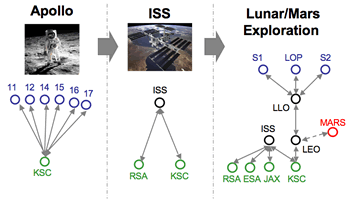About
Interplanetary Supply Chain Management and Logistics Architecture
A vast number of scientific principles and techniques have been developed since World-War-II to improve the effectiveness and efficiency of terrestrial supply-chains in the private and military sectors. The potential benefits of this body-of-knowledge are currently only poorly understood in the context of space exploration.

Sustainable Space Exploration
Sustainable space exploration, however, is impossible without appropriate supply-chain management (SCM). Unlike Apollo, future exploration will have to rely on a complex supply-chain network on the ground and in space. The primary goal of this NASA-funded project is to develop a comprehensive SCM framework and planning tool for space-logistics, which is a critical gap in needed capabilities.
Four steps to an integrated space-logistics capability:
-
Terrestrial supply chain analogies
We investigate and contrast lessons learned from SCM in (i) major industries specialized in "low-quantity", capital-intensive products, (ii) long-range military operations such as aircraft and naval-submarine logistics, and (iii) supply-chains for operations in remote environments, specifically the NASA Haughton-Mars-Project (HMP), which is being developed into the functional equivalent of a Mars Exploration base in the high Arctic (75N 90W). This provides initial class-of-supply and logistics information for modeling purposes. This will categorize the tradeoffs between transportation modes in terms of unit cost, time and availability and the bulk-density and criticality of goods to be transported. We also identify where terrestrial logistics analogies break down, when applied to space exploration.
-
Space Logistics network analysis
We are building an integrated network model of space logistics, where the nodes are Earth-Moon-Mars-orbits, Lagrangian points and expected landing-exploration sites. The arcs represent cargo and element flows between the nodes. These cargo flows are manifested into individual flights. Cargo (and crew) reach a planetary surface using one of the following three modes: (i) pre-deployment, (ii) carry-along with the crew (iii) scheduled or on-demand resupply. One significant difference between terrestrial and space logistics is that the nodal-motion in space creates time and energy dependencies in the network that do not exist on Earth.
-
Exploration demand-supply modeling with uncertainty
Major uncertainties in supply and demand of the space-logistics-network are quantified such as cyclical demand variations, changes in the cargo-mix, transportation costs, and unplanned supply-line interruptions. These models also include storage and lifetime issues (degradation, obsolescence, cryo-boiloff) as well as consumption rates and are used to populate the supply-chain network model in order to run different logistics scenarios, starting with CEV development and deployment (2010-2014), all the way to lunar sortie missions (2018-2020) and the buildup of a lunar outpost (2021-2023). We base the exploration logistics model on a system of 10 functional classes-of-supply (COS), including propellants, crew consumables, spares, and exploration and mobility equipment. The COS are further broken down into sub-classes-of supply.
-
Interplanetary Supply Chain Architecture: Trade Studies
We are combining the network and supply/demand models with existing space logistics models from the Space Shuttle and the International Space Station. This allows us to execute trade studies to help answer the following questions:
- Vertical Integration: Assembly and staging at launch site versus LEO?
- Choice of transportation modes: Effect of bulk-density, value and time-criticality. Relationship to ORU-analysis for ISS?
- Location of facilities and transfer points: optimal placement of intermediate depots and buffers in the space-exploration-network (e.g. for propellant pre-positioning)?
- Push-pull boundary: cargo pre-positioning vs. carry-along vs. ISRU?
- Information architectures: benefits of automatic tagging, status reporting of deployed spares and stocks, space-logistics data-basing?
SpaceNet Software Environment
The space-logistics planning framework is implemented in a software environment referred to as SpaceNet, populated with a detailed human-cargo database. There are currently two versions of SpaceNet:
- SpaceNet 1.3 - Matlab/Excel based version (User Manual)
- SpaceNet 2.5 - Java standalone version (Project Website)
The Phase I model includes nodes and arcs in the Earth-Moon system and allows to run logistics scenarios up to and including buildup of a lunar outpost. The expanded model developed in Phase II will include additional nodes and edges in the Earth-Moon-Mars system and will allow simulating the interplanetary supply chain up to and including Mars missions.
Partners
This project brings to bear a unique combination of academic strengths in space systems and supply chain management at MIT with our partners at:
- Jet Propulsion Laboratory/California Institute of Technology
- United Space Alliance
- Payload Systems Inc. (now Aurura Flight Sciences)
to provide a theoretical and practical foundation for interplanetary supply-chain-management.
Any interplanetary supply-chain has to balance the requirements of reliability (redundant transportation modes) with cost-efficiency (few buffers, routes). We are helping NASA address this challenge directly.
